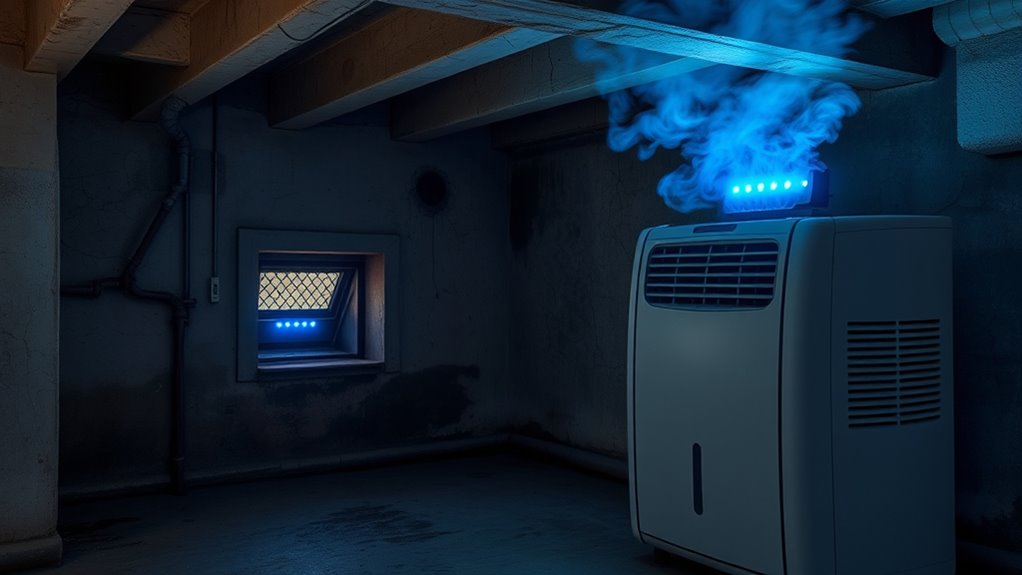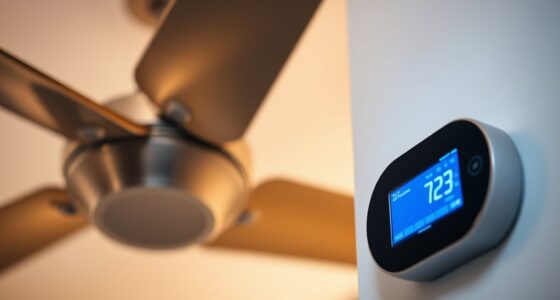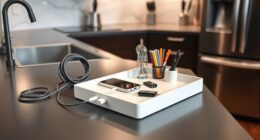To combat a musty basement, use ventilation when outdoor air quality is good and humidity levels are low, as it helps freshen the space and remove odors. However, if outdoor conditions are humid or stagnant, a dehumidifier is more effective at actively reducing excess moisture that causes mold and moldy smells. For the best results, combining both methods works well, and there’s more to contemplate for your specific situation.
Key Takeaways
- Ventilation is effective in mild climates and when outdoor air quality is good, but may be insufficient for high or persistent humidity.
- Dehumidifiers actively remove moisture regardless of outdoor conditions, making them essential in consistently humid environments.
- Combining ventilation and dehumidification provides comprehensive moisture and air quality control, especially in problematic basements.
- Ventilation helps prevent stale air buildup but might not control high humidity levels effectively alone.
- Dehumidifiers are more reliable for maintaining stable, mold-resistant humidity levels when outdoor conditions are poor or variable.

When it comes to managing indoor air quality and moisture levels, choosing between ventilation and a dehumidifier can be confusing. Both options aim to improve your basement’s environment, but they do so in different ways. Understanding how each method influences air circulation and moisture control is key to making the right choice. Ventilation works by bringing in fresh air from outside, which helps dilute indoor pollutants and remove excess humidity. Proper air circulation ensures that moist, stale air doesn’t linger and cause mold or musty odors. If your basement has poor airflow, installing vents, exhaust fans, or opening windows can considerably improve air exchange. This approach is especially effective in mild or ventilated climates where outdoor air isn’t overly humid.
However, ventilation alone might not be enough if your basement experiences high humidity levels or persistent moisture problems. In such cases, introducing a dehumidifier can provide targeted moisture control. These devices actively extract excess moisture from the air, helping to lower humidity to a safer, mold-resistant level—ideally between 30% and 50%. Unlike ventilation, which depends on outdoor air quality and weather conditions, a dehumidifier works continuously, regardless of external factors. It’s particularly useful in humid climates or during seasons when outdoor air is saturated with moisture. By reducing humidity, you prevent condensation on walls, floors, and other surfaces, which is vital for preventing mold growth and structural damage. Additionally, proper dehumidification can contribute to home improvement by protecting your investment and maintaining a healthier living space.
Combining both methods often produces the best results. You can use ventilation to maintain good air circulation and freshen the space while deploying a dehumidifier to keep moisture levels in check. This dual approach not only improves air quality but also stabilizes humidity, creating a healthier basement environment. Keep in mind that the size and capacity of a dehumidifier matter; choose one suited to your basement’s square footage and moisture load. Likewise, ensure your ventilation system is properly installed and maintained, with vents free of blockages and exhaust fans functioning effectively.
Frequently Asked Questions
How Do I Know if Ventilation or a Dehumidifier Is Better?
You should choose based on your basement’s specific needs. If poor air circulation causes stale, damp air, a ventilation system helps improve airflow and reduces moisture. If humidity levels are high, a dehumidifier is more effective for moisture control. Check your basement’s humidity with a hygrometer; if it’s consistently above 60%, a dehumidifier is your best bet. For good air circulation, ventilate regularly to prevent mustiness.
Can I Use Both Ventilation and a Dehumidifier Together?
Sure, you can use both ventilation and a dehumidifier together—because who doesn’t love overdoing it? Ironically, combining air circulation and moisture control actually works best for a musty basement. Ventilation keeps fresh air moving, while a dehumidifier pulls excess moisture from the air. Together, they create an environment where mold and dampness struggle to survive, giving you a healthier, fresher space without the drama.
What Maintenance Is Required for Each Method?
You need to regularly check and replace air filters for your ventilation system to guarantee good air quality. For your dehumidifier, clean the drain and empty the water tank often to prevent mold and odors. Both methods require routine maintenance like inspecting for blockages and keeping vents clear. Doing these simple tasks helps your system work efficiently and keeps your basement fresh and dry.
How Long Does It Take to See Results?
A watched pot never boils, but with moisture control, you’ll see results faster than you think. Typically, you notice improved air quality and reduced mustiness within a few days to a week, depending on the severity. Ventilation starts working almost immediately, while a dehumidifier usually takes a few days to considerably lower moisture levels. Keep consistent, and you’ll enjoy a fresher, healthier basement in no time.
Are There Health Risks Associated With Either Method?
You should be aware that both ventilation and dehumidifiers can impact your health by affecting mold spores and air quality. Ventilation helps clear mold spores and freshen the air, reducing health risks. Dehumidifiers lower moisture, preventing mold growth but might circulate dust if not maintained properly. Regularly check your air quality and keep equipment clean to minimize health risks and maintain a healthier basement environment.
Conclusion
Ultimately, whether you choose ventilation or a dehumidifier, your goal is to guard against musty, moldy misery. Ventilation provides fresh airflow, flushing out foul odors, while a dehumidifier diligently dries dampness. Decide based on your basement’s specifics, but remember: consistent care conquers chaos. By balancing breathability with dryness, you’ll banish basement blight, bringing brightness and buoyancy back to your space. Breathe easy, knowing your basement’s battle is beautifully won.









